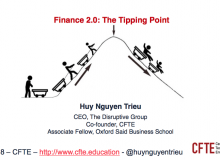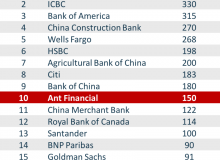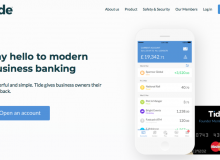The “Fintech” trend started 5 years ago.* Since then, we’ve heard about new startups, the emergence of tech competitors in finance, and also banks investing in technology.
But what has been exactly the impact of technology in finance? Is there a real impact, is it too early to say, or is it just hype?
My view is that the impact has been industry-changing, and the result can be see in real, tangible numbers.
I presented these findings at a keynote in Vietnam a month ago, and you can see the video below. For those who prefer to read text, I’ve also attached the transcript at the end. (it’s only a transcript though, so might be hard to read)
* It’s hard to pinpoint an exact date for “Fintech”. We could argue it really started after the 2008 crisis, which coincided with the birth of the iPhone too. I would put the start of Fintech around 2011 / 2013 though, if only because of the huge amount of investment since.
PS: for readers of Disruptive Finance, you’d have noticed that my blogs are less frequent… A lot of things have happened at CFTE and The Disruptive Group, which is great, but running two companies leaves me no time for blogging, which I regret. I use Linkedin much more now, so don’t hesitate to follow me there (just say you come from Disruptive Finance in the message and I’ll connect you).
Also, if you re looking for interesting content, have a look at my presentation at Money 20/20 about “How to build a bank from scratch” – I spent quite a considerable amount of time to prepare it.
If you want updates on Disruptive Finance and Fintech:
– You can enter your email address to receive an email whenever I write a new post
– You can also follow me on Twitter here
Don’t hesitate to share if you like this post
TRANSCRIPT
Dear minister, dear governor, ladies and gentlemen, good morning.
I’m very honored and I’m very delighted to be here with you today. Thank you very much to ADB and thank you very much to the State Bank of Vietnam for inviting me back here. I would like to share with you during the next 15 minutes what I think is happening in finance today. I called the presentation The Tipping Point.
Why did I call that The Tipping Point? I called it The Tipping Point because, a few years ago, we were seeing that technology would impact finance. It was a question of when, not if. Today in 2018, it has happened, so it’s not a question of when or if, but how has it happened, and what’s happening next?
Let me take you through three main topics which I think were very important a few years ago, and what has happened since.
First, the result of the impact of technology in finance that we’re seeing today is these numbers that were just mentioned. Also, in terms of investment, $100 billion have been invested over the last five years into transforming finance. This is a huge amount of money. This is a huge amount of money which has led to three very big trends, the first one being what I call the hyperscalability of finance.
What is the hyperscalability of finance? It’s really the way that finance is starting to grow in a very different way than what we’ve witnessed for a very, very long time. Let me take an analogy. In banking, you know that in general you can have very, very large organizations. You can have very large organizations, but it takes time.
For example, Citibank, which is the bank where I used to be before, has 200 million clients, but it took 200 years to reach 200 million clients. You can have very large organizations, but it takes time. You can grow faster. For example, in China, ABC is a very large organization, but it still took more than 50 years to reach that amount.
You know, of course, that it is different in the internet world. In the internet world, here I had to cap at 100 years. In the internet world, I had to cap at a billion clients. If you take the example of Facebook, Facebook, two billion clients for a company which is a bit more than 10 years old. You can take the example of LinkedIn, Amazon, Google, all these companies grew over a space of 10 to 20 years to 500 million clients, a billion clients.
The scalability is very, very different in the internet. We have finance, we have digital. What do you think of digital finance? Who thinks that digital finance grows like traditional finance? Who thinks that digital finance grows like digital, like the internet? Most of you are unsure.
Let me show for digital finance. This is digital finance. This is digital finance, and out of Asia, you might have heard about Zhong An. Zhong An digital insure, that didn’t exist in 2013, so it was launched five years ago. 600 million clients. Alipay from Ant Financial, 500 million clients. Paytm in India, 300 million clients for a 10-year company. But it’s not just, of course, about Asia. It’s also in the US. If I was in the US, and if I asked you, “Have you heard about Credit Karma,” most of the room would say yes. Credit Karma is a company that was launched less than 10 years ago, and has more than 1/3 of the US population as clients.
Hyperscalability is coming into finance, which is this. This is very, very important. This is very, very important because the way we think of finance is totally transformed. We can’t just think of finance as the old-traditional finance that will take 20 or 50 years to build large companies. Today in finance you can build very, very large companies in the space of five to 10 years. The tools that we have coming from the internet, the tools that we have coming from digital are totally being applied in finance today.
What is the result? The result is this. The result is that in terms of market capitalization, if it was listed, so Ant Financial, the financial arm of Alibaba is not listed yet, but in the space of 10 years became the 10th largest financial institution in the world. This is what hyperscalability brings to finance. It brings the ability to start from scratch into being some of the largest financial institutions in the world, competing with JP Morgan, Citi, or ICBC, for example.
A few years ago, we were talking about when, not if. Today it’s not when or if, it has happened. This is the first thing that I would like you to remember, which is hyperscalability. When you think of finance today, not like traditional finance. Finance is growing in a very, very different way.
The second topic I wanted to share with you was unbundling and rebundling. I know with some of you in the room, this is now one of my favorite topics, which is the innovation process that you see in a lot of industries, including finance, usually starts with unbundling, and then goes into rebundling. What do I mean by unbundling and rebundling? This would be all the normal activities you would have from a bank. For example, as a user, you could borrow money. You could invest your money. You could bank with your bank. You could pay, and a few years ago, 2012, 2013, 2011, depending on the countries, you started to have the wave of unbundling.
Hundreds and hundreds of companies competing on each single vertical with a very simple value proposition, which is faster, cheaper, better by using more technology. We’ve had this first process of unbundling a few years ago. But if I take the example of Amazon from another industry, you know that unbundling is just the first stage of the process. Amazon started on books, and as they grew and they grew and they grew, they started to rebundle, to offer more and more and more and more. At that time, our forecast was that, of course, that would happen in finance also.
Of course, a lot of the startups that enter on the unbundling side would at some point rebundle. Let me take an example of Revolut, which some of you in the room know that I’m quite fond of Revolut because it’s a beautiful example of unbundling and rebundling. Revolut is a prepaid debit card that basically allows people to pay less fees when they travel abroad. So, very, very simple value proposition where they compete with banks and credit cards. They were started a few years ago, so on this very, very narrow proposition, prepaid debit card for travel. They started on the unbundling side.
What happened after? Since last year, Revolut started to rebundle. They rebundled as they got more and more plans. They started to add insurance products, travel insurance product. Even cryptocurrencies. Result? Revolut is now the fastest-growing financial institution in the UK, and for a company which is less than four years old, is worth $1.7 billion.
First trend, hyperscalability. Second trend, all these hundreds of companies starting from unbundling are getting into rebundling and offering more and more financial services.
Let’s talk about the third trend. The third trend is, banks are getting it, or I put in some banks are getting it. Some are getting it, some are not getting it. This started in 2013, 2014, where a lot of banks, a lot of banks started on their innovation journey, creating innovation labs, starting innovation accelerators, investing in startups. Some banks are getting it.
These are the numbers for Goldman Sachs, Citi, JP Morgan, some of the largest investors, and the number of Fintech startups they’re invested in. You see that Goldman, which was at that time an example of a company which we thought was a really interesting example of banks aggressively getting into Fintech. Goldman Sachs has invested in 37 companies over the last few years.
Same thing for Citibank, where I was, or JP Morgan. But of course, it’s not just about investment, no. Investment is one of the keys of innovation, but it’s not the only key. It’s about investing, developing your internal knowledge about technology, about innovation. Goldman Sachs is an interesting example, because in 2000, I think, 14 it was, or 15, they led an investment into Kensho, a very small investment. $15 million investment into Kensho. What did they get out of it? They got, of course, an investment, but they got much more than that. It was a way for them to start getting into big data and artificial intelligence, and get the know-how of these very smart startups working in the space.
What was the result? The result is this. Kensho was sold a month ago for $550 million to S&P, which was a very good financial deal for Goldman Sachs, but which was an amazing deal in terms of intellectual property. Goldman Sachs learned so much from working with these very fast startups, and of course, the return on investment. I don’t know if you can see in the picture, which is quite interesting, but it was on the trading floor of Goldman Sachs that shows how the calibration worked between these companies. But it’s much more than just about investment. It’s just much more than about return on investment or intellectual property.
How do we, as large organizations, make our digital transformation? There are some very smart people, much smarter than me, who said that to make your digital transformation, you need three things. You need technology, you need process, but before all, you need people. We’re in an industry where it’s all about human capital. Some banks are getting it.
Two of our partners, DBS and OCBC, are investing huge amount of money to train their employees, but to train all their employees. Because in the world of digital, it’s impossible to thrive in finance if you don’t understand technology, whether you’re in middle office, back office, front office, CEO, or chairman, it’s impossible not to understand technology. And so, we’re seeing all these very, very large organizations going from investing into startups, creating innovation labs, doing their accelerators, into investing at scale in their people.
At the end of the day, it is a world where organizations that will have the best people will thrive the most. What is the result? The result is this. At the end of the day, it’s all about business. It’s better business. This is DBS. DBS, one of the companies, one of the banks that has, perhaps, the most interesting strategies in Fintech. On the left-hand side is their results for digital. On the right-hand side is their results for traditional. What did we learn?
We learned something which is totally counterintuitive. When we talk about digital, a lot of people would say, “Digital will allow me to reduce cost.” This is not what we see at DBS. What we see at DBS is that digital allows them to increase revenues. The revenues are twice as much on digital. On traditional, more or less the same cost, which means that the profit are three times bigger on digital than traditional. This is the kind of experience you can only know if you start to do it. Let me talk about the tipping point. Question of when, or if, for me it’s a question of it has happened already.
The tipping point in finance has happened. This is my illustration of the tipping point, which is this mountain, which is this mountain that we know we have to climb, because after the peak, it’s gonna be much easier. If you’re a startup, the reality is that if you’re a startup, it’s much easier. If you’re a startup, you’re much smaller, you’re much nimbler. You will use technology, of course, so if you’re a startup, you know, it’s much easier to climb this mountain. But the thing is that in terms of your impact, you might have a lot of impact, sometimes, but in most other cases, you have a bit of impact.
This is the reality of startups. For incumbents, for large organizations, of course it’s much harder. You know, if you’re a large organization, you have tens of thousands of people. You’re a big, heavy organization. It is much, much harder. You have to pull, basically, the weight of your organization. What do we see at the moment? This is where we’re seeing a lot of differentiation.
We’re seeing some organizations that have made the journey, that have put the efforts for the last three, four, five years, that have invested very, very massively in there. They are starting to get the rewards out of it, that are starting to be very, very profitable because of that. At the same time, we’re seeing some organizations which have totally given up. We’re seeing some organizations that find this journey too difficult, and so are not doing anything.
Of course, for me, that’s not really the answer, because in a world of digital, if you don’t cross that tipping point, it’s just gonna be too late. Let me tell you in terms of the tipping point, and finish in the case of Vietnam. This is clear, that we have passed the tipping point. If you are not convinced, come and see me, and I’ll give you more examples. It is totally clear that we have passed the tipping point, from the startups that have gone through unbundling and rebundling, from the large tech companies which are very heavily leveraging technology to get into finance, but also, and most importantly, from some of the very large banks that have started their journey and reaping the benefits of that.
Let me finish in the case of Vietnam. I started by saying I am very honored to be here today, and am I absolutely delighted. Six month ago, I was also in Vietnam, and we were discussing about some of these initiatives. What a difference six month make. Yesterday, I was one of the judges for the Fintech Challenge Vietnam, and I learned three things.
I learned three things. First, I am incredibly impressed. I am incredibly impressed by what has been done by ADB and the State Bank of Vietnam in the last few month in terms of gathering so many startups. I helped to launch the biggest accelerator of Fintech in Asia, SuperCharger, out of Hong Kong. I can tell you that the first cohort that we had was pretty much the same as the one that you had yesterday in terms of the number of applicants, and the fact that you managed to get very, very good quality startups get in from abroad. So, congratulations for that, because it is very impressive. The second thing that I learned was about the quality of the companies that you got. A few month ago, we were talking about payments, and mobile payments in Vietnam. Yesterday, we were talking of course about mobile payments, but we were also talking about credit scoring. We were talking about SME lending. We were talking about KYC, eKYC, biometrics, and of course, we were talking about financial inclusion. The diversity of the companies which were here yesterday and the quality of these companies is just incredible. The third point, which I was incredibly impressed about, is that the first time we did our accelerator a few years ago in Hong Kong, when also it started in the UK with Level39, Startupbootcamp, et cetera, something we didn’t manage to do which you managed to do really well yesterday was to have this great collaboration between banks and startups. The list of all the partner banks that you have, the projects that people worked on together, the delivery and the implementation they got in just two month is incredible. This is not just for Vietnam. It’s for across the world.
Let me conclude by saying, congratulations for the Fintech Challenge Vietnam. It is incredible. I’m very proud to be back here and to discuss six month later and see all the things that have happened. Congratulations to all of you, and good luck for Fintech in Vietnam. Thank you very much.







